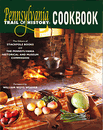Ethnic Mixing Bowl
This article originally appeared in Pennsylvania Trail of History Cookbook
Pennsylvania's cultural diversity is reflected in its rich culinary heritage. Many ethnic groups are represented, including Native Americans; the early Swedish, English, and German settlers; the rich infusion of Eastern and Southern European settlers; Latinos; and African Americans. Pennsylvania's diversification continues to the present with a myriad of new immigrants from all over the world. From the earliest days of the colony to the present, immigrants have enriched the commonwealth with foodways from their native lands.
Early settlers from the British Isles brought their traditions and, where they had access to nearby ports, often imported foodstuffs from overseas. The recipes served at Graeme Park, home of Colonial governor William Keith in Horsham, Montgomery County, reflect this British heritage and the home's access to the port of Philadelphia and its trade goods. Scones *, Scotch eggs *, and colcannon * reflect these influences. The British influence extended to Cornwall Iron Furnace, in Lebanon County, where the ironworkers enjoyed mince meat pies *. While the hard labor of Pennsylvania's coal miners helped build a nation, the immigration of workers from Ireland, England, Wales, Hungary, Austria, Poland, Lithuania, Italy, Russia, Germany, and many other countries also brought a rich diversity to Pennsylvania's table, including pierogies *, holiday ricotta cheese bread *, and halupki *.
At the end of a day in the mines, workers returned home to the wonderful smells of corned beef and cabbage, sausage, sauerkraut, pasties, and pasta. The kitchen was the center of family life where children played and laundry, sewing, and even bathing took place. Family talks, school homework for children not yet working in the mines, and discussions of politics and miners' rights all took place at the kitchen table with the warmth of the coal stove nearby.
Although the mine owners hoped to weaken the influence of labor unions by bringing in workers who did not speak English when they arrived, they also inadvertently enriched the culture of the coal region. Immigrants became part of the rich culture of the area, and their ethnic traditions - including their foods - became part of the wide-ranging ethnic mix that created Pennsylvania's diversity.
The Anthracite Heritage Museum in Scranton, Lackawanna County, is open year-round for visitors to learn about the lives of miners and see re-creations of family homes, kitchens, pubs, and churches. Eckley Miners' Village in Carbon County is a real-life company town.
* Recipes for these dishes are available in the Pennsylvania Trail of History Cookbook
Visit
Graeme Park, Horsham, PA
The only surviving home of a colonial governor.
Cornwall Iron Furnace, Lebanon, PA
America's most complete charcoal-fueled iron-making complex.
Pennsylvania Anthracite Heritage Museum, Scranton, PA
Discover the people of Pennsylvania's anthracite coal region from the days when hard coal was king.
Eckley Miners' Village, Weatherly, PA
An authentic 19th-century coal patch town with miners' houses, churches, a doctor's office and general store.
For Further Reading
 |
Pennsylvania Trail of History Cookbook Edited by Kyle R. Weaver, Diane B. Reed, and Fred Lauver Forward by William Woys Weaver Stackpole Books and Pennsylvania Historical and Museum Commission 2004 |
 |
Graeme Park: Pennsylvania Trail of History Guide by Lorett Treese Stackpole Books and Pennsylvania Historical and Museum Commission 2003 |
 |
Cornwall Iron Furnace: Pennsylvania Trail of History Guide by Susan Dieffenbach Stackpole Books and Pennsylvania Historical and Museum Commission 2003 |
 |
Anthracite Heritage Museum and Scranton Iron Furnaces: Pennsylvania Trail of History Guide by Harold W. Aurand Stackpole Books and Pennsylvania Historical and Museum Commission 2002 |
 |
Eckley Miners' Village: Pennsylvania Trail of History Guide by Perry Blatz Stackpole Books and Pennsylvania Historical and Museum Commission 2003 |


